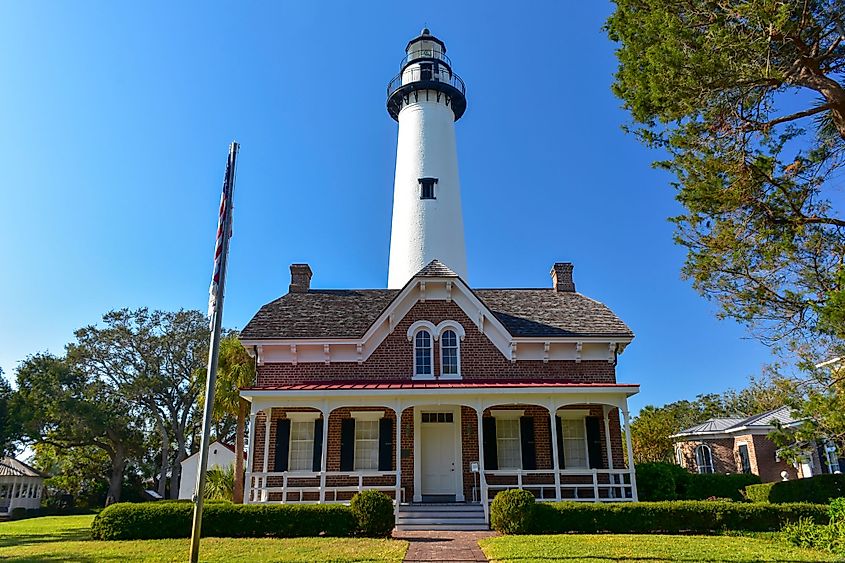
Saint Simons Island, Georgia
Saint Simons Island is a residential and seaside resort community located in Glynn County, Georgia, United States. It is considered the largest of Georgia’s renowned Golden Isles, which include Jekyll Island, Sea Island, and the privately owned Little St. Simons Island. The warm climate and beaches draw visitors to enjoy their vacation and explore the historical sites and Saint Simon Island’s natural environment.
The Geography And Climate Of Saint Simons Island

Saint Simons Island is part of a cluster of barrier islands and marsh hammocks situated between St. Simons Sound to the south and the Altamaha River delta to the north. The eastern edge of this cluster is formed by the Sea Islands, with the Little St. Simons in the north and the marshes of Glynn and Intracoastal Waterway in the west. St. Simons Island covers a total area of 46 sq. km, of which 4.4 sq. km is occupied by water, and 41 sq. km is occupied by land.
According to the Köppen Climate Classification, Saint Simons Island experiences a humid subtropical climate, with comparatively high temperatures and evenly distributed precipitation throughout the year. The average temperature in Saint Simons Island is 20.6 °C. The hottest month is July, with an average temperature of 27.8 °C, while January is the coolest month having an average temperature of 12.8 °C. Saint Simons Island experiences, on average, 84.4 days of rainfall. The average precipitation for the year in Saint Simons Island is 1308.6 mm. The month with the most rain is September, while November receives the least precipitation.
Brief History Of Saint Simons Island

Many scholars identified the people of St. Simons Island as Guale. They suggest that it was occupied by the Guale people when Europeans arrived in southeastern Georgia in the 16th century. The scholars also suggest that the original Guale population on St. Simons got displaced from different parts of the island after the Guale rebellion of 1579 and was replaced by Timucua speaking Mocama people. Between 1579 and 1609, San Buenaventura de Guadalquini, a Spanish mission, was established on the southern edge of St. Simons Island. During the American Civil War, the Confederate troops occupied St. Simons Island. However, the Confederate forces were soon relocated, and the Union army occupied the island for the remainder of the war. The war left the island plantations in ruins, forcing many landowners to move inland to pursue other occupations, leaving the island's economy dormant for several years. Formerly enslaved people later established a community in the center of the island known as Harrington. A German U-boat sank two oil tankers near the island during World War II. The McKinnon Airport became Naval Air Station St. Simons, home to the Navy Radar Training School. After the war ended, the vacation and resort travel increased, and permanent residential development began to take place on St. Simons Island. From 1706 residents in 1950, the island's population grew to 13,381 by 2000.
The Population Of Saint Simons Island
As of 2019, St. Simons Island had 14,778 residents with a median age of 55. The population of St. Simons Island grew by 3.3% between 2018 and 2019 from 14,302 residents to 14,778. The five dominant ethnic groups found in St. Simons Island include the non-Hispanic White (93%), African Americans at 2.57%, followed by Hispanic White at 1.71%, and other ethnicities and Asians at 1.8 %. All residents in St. Simons Island speak English as their primary language at home, and 98% of the population of St. Simons Island are American citizens. In comparison, around 4% of the population were born outside the United States. The most common birthplace of those citizens is Mexico, India, and Korea.
The Economy Of Saint Simons Island

The median household income of residents in St. Simons Island is $87,248. The median household income increased from $85,350 to $87,248, which is a 2.22% increase. Females in St. Simons have an average income that is 1.36 lower than the average income of males. This is reflected in the income inequality in Georgia (measured using the Gini index), which scored 0.477 but remained lower than the national average.
The economy in St. Simons Island employs around 7170 people. As of 2019, the most prominent industries in St. Simons Island were Accommodation & Food Services, which employ more than 1,020 people, followed by Professional, Scientific, & Technical Services, which employ around 860 people, and Educational Services, employing more than 800 people. Public Administration, Information, and Manufacturing industries are considered the highest paying industries in the city.
Visiting St. Simons Island

St. Simons Island attracts many visitors with its beaches and scenic vistas. Visitors enjoy water sports, sailing, fishing, historical sites, and a laid-back lifestyle. The Sea Island Golf Club was ranked as one of America’s top 50 golf courses by Golf Digest in 2013. Ecotourists are drawn to St. Simons Island’s natural surroundings, bird-watching opportunities, and Cannon’s Point Preserve.
Fort Frederica National Monument

Visitors also go to Fort Frederica National Monument, which honors the preserved remains of the 18th-century fortifications built to protect the southern boundary of the British colony of Georgia from the Spaniards. The fort was constructed between 1736 and 1748 by James Oglethorpe and had more than 600 British troops. It was named after Frederick, Prince of Wales and son of King George II. The Fort Frederica National Monument was added to the US National Register of Historic Places on October 15, 1966.







